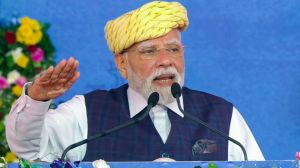Meet STF: states’ terrible failure
When the joint Special Task Force (STF) of Tamil Nadu and Karnataka launched a fresh wave of anti-Veerappan operations on June 21 last year,...

When the joint Special Task Force (STF) of Tamil Nadu and Karnataka launched a fresh wave of anti-Veerappan operations on June 21 last year, it was predicted that they would fail. It was the arrival of monsoon which fuelled such pessimism. For, during the rains, the forests in which Veerappan operates do not allow any concerted police action — the grass grows thick masking any tracks and the rivulets swell dangerously. And this in an area seven times that of the Jaffna forests which shelter the LTTE. ‘‘When 1.5 lakh Indian soldiers could not nab Prabhakaran, is it easy for a 4000-strong task force to hunt down Veerappan?’’ sceptics quipped.
That, in short, is the story behind the STF’s failure. It is always at the wrong place at the wrong time.
|
Focus On Negotiation
|
||
|
* Tamil Nationalist Movement leader Pazha Nedumaran, who has been lodged in jail under POTA, has offered to mediate with Veerappan for Nagappa’s release. ‘‘I will prove my innocence in the court and get released. I am ready to offer my services to defuse the tension between the two states,’’ he said. * Law Minister D.B. Chandre Gowda said negotiating with Veerappan was the first option. * Krishna has written to Dy PM Advani to provide arms and assistance to the state to track down the brigand. * The state has contacted some persons, including wildlife photographers Krupakar and Senani (former Veerappan hostages), and advocate Venugopal, who had appeared for those held under TADA at Mysore jail. * Nagappa’s family met Krishna at his residence. * Krishna has met JD (U) state president C. Byre Gowda at least twice. (ENS) Story continues below this ad |
||
Earlier, following Rajkumar’s release, the STF came up with a two-pronged strategy: while one team tracked Veerappan, the other led by the TN Police Q Branch focussed on nabbing Tamil Nadu Liberation Army (TNLA) and Tamil Nadu Retrieval Troop (TNRT) members who were suspected to be in touch with the bandit.
First, the police wanted to break the Veerappan-Maran nexus as they believed the Tamil activist was behind Rajkumar’s abduction. Soon, the Q Branch picked up Maran, Muthukumar and others, while the Karnataka STF arrested Kulathur Mani and Sivasubramaniam, before targetting Nakkeeran Gopal.
However, all was not well in the STF ranks. When former DGP Walter Dawaram returned from retirement to take over as the joint chief, it was viewed as the rehabilitation of a retired officer. The other leading officer from TN, Vijay Kumar, managed to make a difference through his systematic approach. He handpicked 1000-odd members from among 3000 men who were initially called for the operation. Once the operations began, he divided the TN STF into 12 sectors, each covering large tracts of forest from Kerala’s Walayar to Karnataka’s Bandipur.
But soon Kumar was shunted out. If the transfer of the equally efficient IGP, Kempaiah, from the Karnataka STF has kicked up a row now, the mood was similar when Kumar was shifted out of the TN STF. Kumar, was made the Chennai Police Commissioner upon his promotion as Additional DGP. Another factor that marked the Kumar-Kempaiah combination was their teamwork. Now, with both the officers out of the STF, there is a lack of coordination.
Today, if the STF finds itself on the defensive with a woefully pathetic track record, it has only itself and the two supervising State Governments to blame. Between 1990 and 2001, Karnataka’s expenditure on this operation has been about Rs 112 cr, while Tamil Nadu has spent about Rs 49 crore since 1996. Need we say more?
Photos



- 01
- 02
- 03
- 04
- 05




























